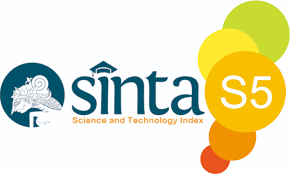Pembelajaran Sholat Berbasis Mobile Android Pada Siswa SMP Negeri 07 Mukomuko
Abstract
Prayer is a medium of communication between humans (Muslims) and Allah Subhanahu Wa Ta'ala, and there are other ways and media. This second pillar of Islam becomes the act of worship of one's servant to his Creator, a way to be close to oneself based on the wisdom of the movements that exist and are carried out in prayer, whether it is obligatory prayer or sunnah prayer. The junior high school stage is a time where students and students grow up so they need to learn to pray in more detail, complete with the pillars and sunnah contained in the prayer service. But at the same time, students are more fond of playing games and social media so that the desire to learn is slightly reduced because they are in the puberty phase who always prioritize hobbies over studying. Learning about prayer worship at the 07 Mukomuko State Junior High School is only taught in religious lessons and the curriculum is general prayer worship, which is limited to the pillars of prayer, movements and readings in prayer itself which are the same as prayer books that are widely circulated in the community. Learning to pray is important because there are several sunnahs in praying that must be done so that students can worship more solemnly and increase the value of the reward in their prayers. There is also etiquette when praying in congregation which is not taught at school but must be known so that it can help provide more knowledge when students pray in congregation in their respective mosques. For this reason, technological assistance is needed that can provide this knowledge more attractively to students. One of them is to use android technology which is currently in vogue. By building a more interesting prayer learning application, it can increase student interest in learning it. The application will provide knowledge with videos, pictures and readings to make it more interesting so that the desire to learn increases. The android mobile-based prayer learning application for students of SMP Negeri 07 Mukomuko was built using the java and xml programming languages in the android studio 4.1 software. Applications can display prayer guidance, ablution, prayer and remembrance. The application is presented in two modes, namely reading and video. The application is built in offline mode so it does not require internet data to use.
Downloads
References
Anamisa, D. R. (2015). Rancang Bangun Aplikasi Sholat Fardhu Dan Sunnah Beserta Kumpulan Do ’ a Berbasis Android. 978–979.
Nurhadi, & Zulkifli. (2020). Sholat Tanpa Tuma’ninah Perspektif Imam Malik dan Imam Abu Hanifah. Nuansa: Jurnal Studi Islam Dan Kemasyarakatan 13, No. 1, XIII(1), 91–105.
Oktavia, P., & Frindo, M. M. (2020). Aplikasi Panduan Sholat Wajib dan Sholat Sunnah Berbasis Android. Jurnal Informatika Universitas Pamulang, 5 (2), 175. https://doi.org/10.32493/informatika.v5i2.4925.
Prambayun, A., & Prawira, R. (2019). Aplikasi Tuntunan Sholat Pada Smartphone Berbasis Android. Jurnal Informatika Lembah Dempo, 7(2), 25–37.
Safaat, N. (2011). Android: Pemrograman Aplikasi Mobile Smartphone dan Tablet PC. Informatika.
Safaat, N. (2012). Pemrograman Aplikasi Mobile Smartphone dan Tablet PC Berbasis Android. Informatika.
Safrawali. (2021). Penyuluhan Penyempurnaan Praktek Ibadah Sholat Kepada Jamaah Islamic Cakrukan Ummatan Wahidah Dusun XVI Pasar 3 Tembung. J-LAS (Journal Liaison Academia and Society), 1(1), 39-47, 1.
Copyright (c) 2024 Dandi Sunardi, Anisya Sonita, Muntahanah Muntahanah, Zainove Sandi

This work is licensed under a Creative Commons Attribution-ShareAlike 4.0 International License.
An author who publishes in Jurnal Media Infotama agrees to the following terms:The author holds the copyright and grants the journal the right of first publication of the work simultaneously licensed under the Creative Commons Attribution-Share Alike 4.0 License which allows others to share the work with acknowledgment of the work's authorship and initial publication in this journal.Submission of a manuscript implies that the submitted work has not been previously published (except as part of a thesis or report, or abstract); that it is not being considered for publication elsewhere; that its publication has been approved by all co-authors. If and when a manuscript is accepted for publication, the author retains the copyright and retains the publishing rights without limitation.
For new inventions, authors are advised to administer the patent before publication. The license type is CC-BY-SA 4.0.
MEDIA INFORMATION REVIEW: Journal of the Faculty of Computer Science is licensed under a Creative Commons Attribution-ShareAlike 4.0 International License.You are free to:Share
— copy and redistribute material in any medium or formatAdapt
— remix, modify and develop materialfor any purpose, even commercial.
The licensor cannot revoke this freedom as long as you follow the license terms












.png)


